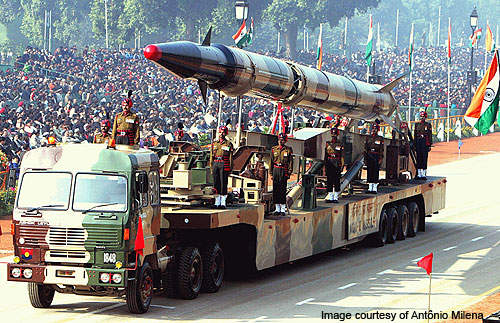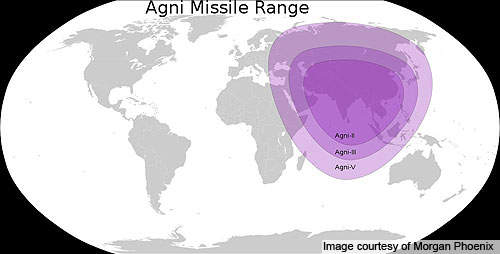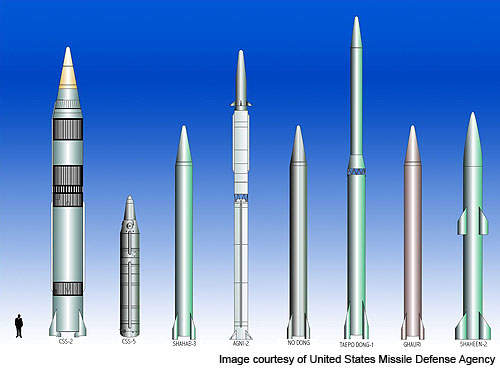The Agni series of ballistic missiles is being developed under the Integrated Guided Missile Development Programme of the Defence Research and Development Organisation of India.
The Agni missile family consists of three deployed variants. The Agni-I, Agni-II and Agni-III are in service with the Indian Army. Agni-IV, the fourth in the Agni series of missiles, has completed all trials successfully by January 2017. A new intercontinental ballistic missile variant, the Agni-V, is also being developed and is expected to enter service by 2017-18.
Agni-I short-range ballistic missile
The Agni-I is a short or intermediate-range ballistic missile. It was first tested at the interim test range in Chandipur off the coast of Orissa, India, in May 1989.
The missile consists of a single engine. In March 2010, a nuclear-capable Agni-I was test fired from the integrated test range at Wheeler Island off the Orissa coast.
The strap-down inertial navigation system uses an explicit guidance method. The structure is made of all-carbon composite materials to protect the payload during its re-entry stage. The flight trials proved the long-range capabilities of the missile. The missile can carry a conventional payload of 1,000kg or a nuclear warhead and has a range between 700km and 800km. These are transported by rail and road, and powered by solid propellants.
Agni-II medium-range ballistic missile
The Agni-II is a medium-range ballistic missile equipped with two solid fuel stages. It was test fired in April 1999 from the IC-4 pad. The nuclear-capable Agni-II was tested by a special strategic command force in May 2010. The missile has a range of more than 2,000km and can reach most of the western, central and southern parts of China. A tank missile with top-attack, fire and forget capability was also inducted into service.
Agni-III intermediate range ballistic missile
The Agni-III was test fired in July 2006 from Wheeler Island, but failed to reach its target. It was successfully test fired in April 2007. A third test in May 2008 proved the operational readiness of the missile. With a circular error probable under a 40m range, the missile is considered one of the most accurate strategic ballistic missiles of its range class in the world.
The two-stage ballistic missile has a diameter of 2m. The first-stage booster weighs around 32t and is made using advanced carbon composite materials, while the second-stage booster weighs 11t and is made of iron-based steel alloy. The missile can support a series of warhead configurations and a total payload of 2,490kg for a range of 4,500km.
Agni-IV intermediate range ballistic missile
Agni-IV is a two-stage nuclear-capable intermediate range ballistic missile. The missile was first tested in November 2011 from Wheeler Island. It rose to an altitude of 900km during the test. It was successfully test-fired again in September 2012. It reached an altitude of 850km during its third test in January 2014. The missile was also successfully test-fired in January 2017.
The Agni-IV has a length of 20m and weight of 17t. It can carry a payload of 800kg. The maximum range of the missile is 4,000km.
Manoeuvring re-entry vehicle
The Agni’s manoeuvring re-entry vehicle features an attitude control system and aerodynamic fins. The 4m-long re-entry vehicle consists of five sections, with each section consisting of a two-layer composite structure. The MRV supports a range of payloads in different configurations.
Navigation and control
The Agni series utilises a strap-down inertial navigation system (INS) for flight control and navigation. These missiles incorporate indigenously developed inertial sensors. The Agni-II’s missile control system uses an MIL-STD-1553 data bus for all on-board communication and control device interconnection. The system integrates the INS, flight control computer, actuators and sensors.
Navigation and guidance is provided by an advanced ground-based beacon system that uses the time delay of arrival (TDOA) concept. The TDOA continuously provides updates on missile flight position and speed.
The Agni-IV is guided by a Ring Laser Gyro based INS, Micro Navigation System and Digital Controller System.
Propulsion
The Agni-I is propelled by a single-stage engine powered by solid fuel. The Agni-II is powered by a two-and-half-stage solid propellant engine, while the Agni-III and Agni-IV are powered by a two-stage solid propellant engine.







